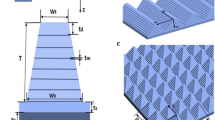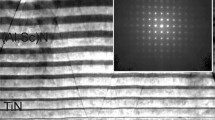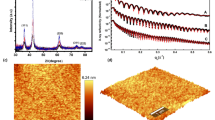Abstract
Titanium nitride (TiN) metadevices as perfect absorbers are studied using finite-difference time-domain (FDTD) simulations. In this paper, we demonstrate a metastructure including a top silica (SiO2) layer, two layers of TiN nano-ribbon arrays, a SiO2 dielectric layer, and a TiN film to realize efficient solar energy harvesting. We theoretically optimize the geometrical parameters of each active layer to achieve high absorption rates with an average value of up to 95% within an ultra-wide band from 0.4 to 1.8 microns, covering over 93% of total energy in the solar spectrum. Our detailed analysis of the electric field enhancement indicates that such ultra-broadband high absorption in the visible/near-infrared ranges can be attributed to surface plasmon resonances, Fabry-Perot resonances, and strong plasmon hybridization between adjacent TiN nano-ribbons. Together with refractory properties of TiN and SiO2, the designed metadevice may exhibit great potential in efficient solar energy harvesting applications, particularly in harsh environments.










Similar content being viewed by others
Data Availability
The datasets analyzed during the current study are available from the corresponding author on reasonable request.
References
Blankenship RE, Tiede DM, Barber J, Brudvig GW, Fleming G, Ghirardi M, Gunner MR, Junge W, Kramer DM, Melis A, Moore TA, Moser CC, Nocera DG, Nozik AJ, Ort DR, Parson WW, Prince RC, Sayre RT (2011) Comparing photosynthetic and photovoltaic efficiencies and recognizing the potential for improvement. Science 332(6031):805–809
Wu S, Xiong G, Yang H, Gong B, Tian Y, Xu C, Wang Y, Fisher T, Yan J, Cen K, Luo T, Tu X, Bo Z, Ostrikov K (2019) Multifunctional solar waterways: Plasma-enabled self-cleaning nanoarchitectures for energy-efficient desalination. Advanced Energy Materials 9(30):1901286
Bhardwaj S, Pathak NK, Ji A, Uma R, Sharma RP (2017) Tunable properties of surface plasmon resonance of metal nanospheroid: graphene plasmon interaction. Plasmonics 12(1):193–201
Lu R, Xu L, Ge Z, Li R, Xu J, Yu L, Chen K (2016) Improved efficiency of silicon nanoholes/gold nanoparticles/organic hybrid solar cells via localized surface plasmon resonance. Nanoscale Res Lett 11(1):160
Manai L, Dridi Rezgui B, Benabderrahmane Zaghouani R, Barakel D, Torchio P, Palais O, Bessais B (2016) Tuning of light trapping and surface plasmon resonance in silver nanoparticles/C-Si structures for solar cells. Plasmonics 11(5):1273–1277
Pang Y, Zhang J, Ma R, Qu Z, Lee E, Luo T (2020) Solar–thermal water evaporation: a review. ACS Energy Letters 5(2):437–456
Lee E, Huang D, Luo T (2020) Ballistic supercavitating nanoparticles driven by single Gaussian beam optical pushing and pulling forces. Nature Communications 11(1):2404
Wang BX, Zhai X, Wang G-Z, Huang W-Q, Wang L-L (2015) A novel dual-band terahertz metamaterial absorber for a sensor application. J Appl Phys 117(1):014504
Wang BX, Wang G, Wang L, Zhai X (2016) Design of a five-band terahertz absorber based on three nested split-ring resonators. IEEE Photonics Technology Letters 28(3):307–310
Wang BX, Wang G-Z, Sang T (2016) Simple design of novel triple-band terahertz metamaterial absorber for sensing application. J Phys D Appl Phys 49(16):165307
Wang BX, Wang G-Z, Wang L-L (2016) Design of a novel dual-band terahertz metamaterial absorber. Plasmonics 11(2):523–530
Wang BX (2017) Quad-band terahertz metamaterial absorber based on the combining of the dipole and quadrupole resonances of two SRRs. IEEE Journal of Selected Topics in Quantum Electronics 23(4):1–7
Wang BX, Wang G-Z, Sang T, Wang LL (2017) Six-band terahertz metamaterial absorber based on the combination of multiple-order responses of metallic patches in a dual-layer stacked resonance structure. Scientific Reports 7(1):41373
Wang BX, Tang C, Niu Q, He Y, Chen T (2019) Design of narrow discrete distances of dual-/triple-band terahertz metamaterial absorbers. Nanoscale Res Lett 14(1):64
Wang BX, He Y, Lou P, Huang WQ, Pi F (2020) Penta-band terahertz light absorber using five localized resonance responses of three patterned resonators. Results in Physics 16:102930
Wang BX, He Y, Lou P, Xing W (2020) Design of a dual-band terahertz metamaterial absorber using two identical square patches for sensing application. Nanoscale Advances 2(2):763–769
Gao M, Zhu L, Peh CK, Ho GW (2019) Solar absorber material and system designs for photothermal water vaporization towards clean water and energy production. Energy & Environmental Science 12(3):841–864
Maier SA (2007) Plasmonics: Fundamentals and applications. In. p 245
Wang BX, Tang C, Niu Q, He Y, Chen R (2019) A broadband terahertz metamaterial absorber enabled by the simple design of a rectangular-shaped resonator with an elongated slot. Nanoscale Advances 1(9):3621–3625
Li W, Guler U, Kinsey N, Naik GV, Boltasseva A, Guan J, Shalaev VM, Kildishev AV (2014) Refractory plasmonics with titanium nitride: broadband metamaterial absorber. Advanced Materials 26(47):7959–7965
Chernyshev AP (2009) Effect of nanoparticle size on the onset temperature of surface melting. Materials Letters 63(17):1525–1527
Patsalas P, Kalfagiannis N, Kassavetis S (2015) Optical properties and plasmonic performance of titanium nitride. Materials 8(6):3128–3154
Naik GV, Kim J, Boltasseva A (2011) Oxides and nitrides as alternative plasmonic materials in the optical range [Invited]. Opt Mater Express 1(6):1090–1099
Naik GV, Shalaev VM, Boltasseva A (2013) Alternative plasmonic materials: beyond gold and silver. Advanced Materials 25(24):3264–3294
Guler U, Shalaev VM, Boltasseva A (2015) Nanoparticle plasmonics: going practical with transition metal nitrides. Materials Today 18(4):227–237
Habib A, Florio F, Sundararaman R (2018) Hot carrier dynamics in plasmonic transition metal nitrides. Journal of Optics 20(6):064001
Cortie MB, Giddings J, Dowd A (2010) Optical properties and plasmon resonances of titanium nitride nanostructures. Nanotechnology 21(11):115201
Ishii S, Shinde SL, Sugavaneshwar RP, Kaur M, Nagao T (2018) Harvesting sunlight with titanium nitride nanostructures. In: 2018 Progress in Electromagnetics Research Symposium (PIERS-Toyama), 1-4 Aug. pp 1286-1289
Guler U, Naik GV, Boltasseva A, Shalaev VM, Kildishev AV (2012) Performance analysis of nitride alternative plasmonic materials for localized surface plasmon applications. Applied Physics B 107(2):285–291
Guler U, Ndukaife JC, Naik GV, Nnanna AGA, Kildishev AV, Shalaev VM, Boltasseva A (2013) Local heating with lithographically fabricated plasmonic titanium nitride nanoparticles. Nano Letters 13(12):6078–6083
Naik GV, Schroeder JL, Ni X, Kildishev AV, Sands TD, Boltasseva A (2012) Titanium nitride as a plasmonic material for visible and near-infrared wavelengths. Opt Mater Express 2(4):478–489
Wang J, Zhang W, Zhu M, Yi K, Shao J (2015) Broadband perfect absorber with titanium nitride nano-disk array. Plasmonics 10(6):1473–1478
Gao H, Peng W, Liang Y, Chu S, Yu L, Liu Z, Zhang Y (2019) Plasmonic broadband perfect absorber for visible light solar cells application. Plasmonics 15:573–580
Ishii S, Shinde SL, Jevasuwan W, Fukata N, Nagao T (2016) Hot electron excitation from titanium nitride using visible light. ACS Photonics 3(9):1552–1557
Kamakura R, Murai S, Ishii S, Nagao T, Fujita K, Tanaka K (2017) Plasmonic–photonic hybrid modes excited on a titanium nitride nanoparticle array in the visible region. ACS Photonics 4(4):815–822
Podder S, Pal AR (2019) Plasmonic visible-NIR photodetector based on hot electrons extracted from nanostructured titanium nitride. Journal of Applied Physics 126(8):083108
Liang Q, Fu Y, Xia X, Wang L, Gao R (2018) Titanium nitride nano-disk arrays-based metasurface as a perfect absorber in the visible range. Modern Physics Letters B 32(01):1750365
Gao H, Peng W, Cui W, Chu S, Yu L, Yang X (2019) Ultraviolet to near infrared titanium nitride broadband plasmonic absorber. Optical Materials 97:109377
Juneja S, Shishodia MS (2019) Surface plasmon amplification in refractory transition metal nitrides based nanoparticle dimers. Optics Communications 433:89–96
Palik ED (1985) Handbook of optical constants of solids. Academic Press, Orlando
Haynes WM (2014) CRC handbook of chemistry and physics. CRC press
Gonçalves PAD, Xiao S, Peres NMR, Mortensen NA (2017) Hybridized plasmons in 2D nanoslits: from graphene to anisotropic 2D materials. ACS Photonics 4(12):3045–3054
Nikitin AY, Low T, Martin-Moreno L (2014) Anomalous reflection phase of graphene plasmons and its influence on resonators. Physical Review B 90(4):041407
Liu Z, Aydin K (2016) Localized surface plasmons in nanostructured monolayer black phosphorus. Nano Letters 16(6):3457–3462
Li M, Shen H, Zhuang L, Chen D, Liang X (2014) SiO2 antireflection coatings fabricated by electron-beam evaporation for black monocrystalline silicon solar cells. International Journal of Photoenergy 2014:1–5
Fang C, Liu Y, Han G, Shao Y, Zhang J, Hao Y (2018) Localized plasmon resonances for black phosphorus bowtie nanoantennas at terahertz frequencies. Opt Express 26(21):27683–27693
Meng Y-L, Tan J, Xu K, Chen J, Jin G-J, Sun Y, Wang L-L, Zuo Z, Qin H-Y, Zhao Y, Guo J (2019) Salisbury screen optical color filter with ultra-thin titanium nitride film. Appl Opt 58(24):6700–6705
Ahangarani S, Sabour Rouhaghadam AR, Azadi M (2016) A review on titanium nitride and titanium carbide single and multilayer coatings deposited by plasma assisted chemical vapor deposition. Int J Eng Technol 29(5):677–687
Acknowledgments
The authors thank Dr. Eungkyu Lee for the help and discussion involved in this work.
Funding
The authors received the financial support from University of Nevada, Reno startup fund, The University of Texas at Dallas startup fund, and National Science Foundation (Grant No. CBET-1937949 and CBET-1937923).
Author information
Authors and Affiliations
Contributions
All authors contributed to the study conception and design. Under the supervision of G.X., S.W. performed simulations and theoretical calculations. G.X., S.W., and T.L. analyzed the data and interpreted the results. S.W. wrote the first draft of the manuscript, and all authors contributed to the writing of the manuscript and approved the final manuscript.
Corresponding author
Ethics declarations
Competing Interest
The authors declare that they have no competing interest.
Ethical Approval
Not applicable.
Consent to Participate
Not applicable.
Consent to Publish
Not applicable.
Additional information
Publisher’s Note
Springer Nature remains neutral with regard to jurisdictional claims in published maps and institutional affiliations.
Electronic supplementary material
Below is the link to the electronic supplementary material.
Rights and permissions
About this article
Cite this article
Wu, S., Luo, T. & Xiong, G. Plasmon Hybridization-Induced Ultra-broadband High Absorption from 0.4 to 1.8 Microns in Titanium Nitride Metastructures. Plasmonics 16, 799–809 (2021). https://doi.org/10.1007/s11468-020-01324-2
Received:
Accepted:
Published:
Issue Date:
DOI: https://doi.org/10.1007/s11468-020-01324-2




